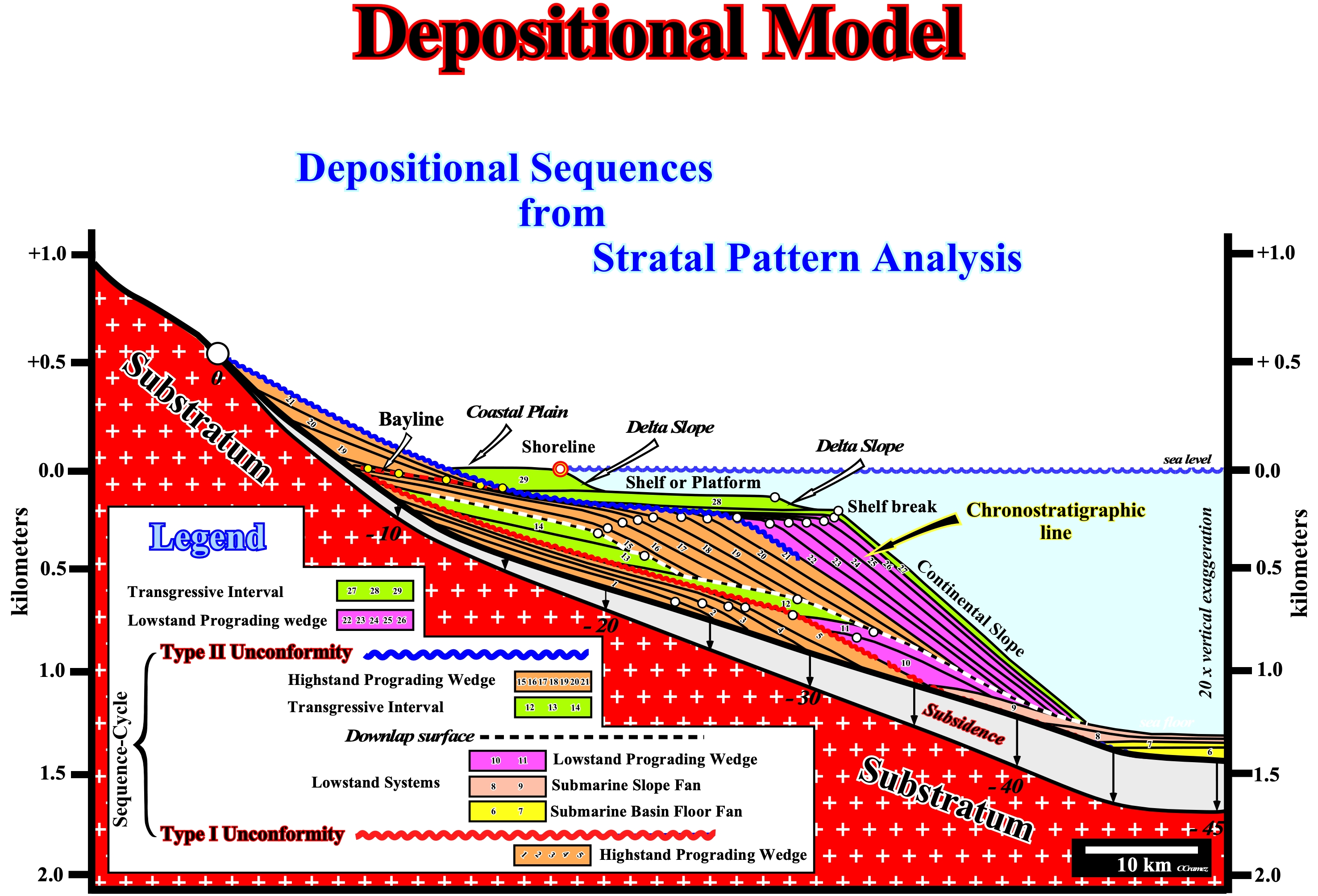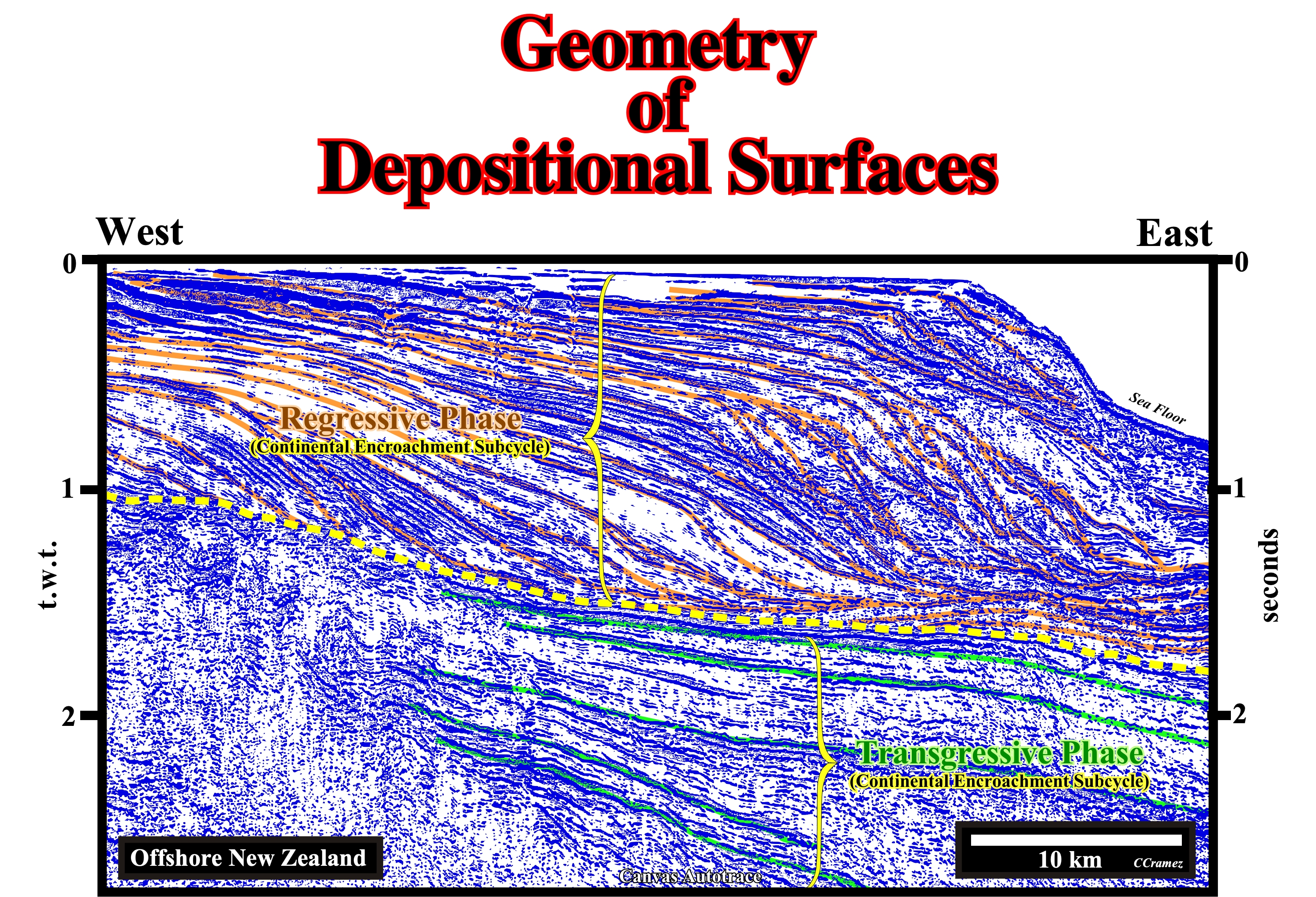

6) Geometry of Depositional Surfaces
At the scale of a sedimentary basin, all chronostratigraphic depositional surfaces have, a geometry, more or less, sigmoidal, with subhorizontal sectors confined by seaward dipping sectors.
In the sand-shale depositional model illustrated below (figure 027), P. Vail and coauthors (1977) considered sedimentary building blocks which they he termed sequences, that later we have called sequence-cycles:
"Succession of genetically related strata (or associated seismic reflections) bounded by unconformities or their correlative conformities deposited during a 3rd order cycle of sea level change between two relative falls of sea level (Mitchum et al., 1977)”

Figure 027- This depositional model was, initially, proposed by P. Vail and co-authors for sand-shale facies. Later some terms were changed. Three sedimentary intervals bounded by unconformities are, easily, recognized. They are named sequence-cycles, i.e., stratigraphic cycles deposited during 3 rd order eustatic cycles. The intermediate interval (6 to 21) comprises all intervening strata of a sequence-cycle. The others are incomplete. In the lower interval (1 to 5), only the regressive highstand deposits (highstand prograding wedge, HPW) are present. On the contrary, in the upper interval (22-29), the regressive lowstand deposits (lowstand prograding wedges, LPW) of the lowstand systems and the transgressive deposits of the transgressive Interval (TI) are present. It is interesting to notice during a complete sequence-cycle, the basin has no shelf (platform) during the deposition of the lowstand systems (composed by three members : Submarine Basin Floor Fans (SBFF), Slope Fans (SSF) and Lowstand Prograding Wedge (PW)). The basin starts to have a platform during the transgressive interval (TI). The platform reaches the maximum of extension at the onset of the highstand systems tracts, when the relative sea level starts to rise in deceleration, However, as the shoreline progrades seaward, the extension of the continental platform becomes, progressively, smaller till it disappear. When the basin has a platform, the shoreline, more or less, the depositional coastal break is continentward of the shelf break, which corresponds to the basin edge (the edge of the basin corresponds, in French to the “rebord du bassin “ and in Spanish to the “borde de la cuenca”). However, when the basin has no-shelf, the depositional coastal break is, more or less, coincident with the edge of basin. On the other hand, it depicts, clearly, the difference between delta and continental slopes. Beyond the different in the amplitude of the height, delta slopes are located landward of the shelf break, while continental slopes are located seaward of the shelf break, when the basin has a shelf, and seaward of the basin edge, when the basin has no-shelf. Put differently, a delta slope is disconnect of the continental slope, when the basin has a shelf and connected with the upper part of the continental slope when the basin has no-shelf.
In this model, Exxon's geoscientists assumed :
1 - Eustasy is the main factor driving the cyclicity of sedimentary deposits ;
2 - Subsidence and Terrigeneous Influx rates are smaller than sea level changes, i.e., than Eustasy ;
3 - Eustasy, Subsidence, Accommodation, Terrigeneous Influx and Climate are major parameter affecting the stratal patterns ;
4 - Terrigeneous Influx is constant in Time and Space ;
5 - Subsidence increases basinward , gradually and linearly ;
6 - Sedimentary intervals have high completeness13.13 The completeness of a given sedimentary interval is the relationship between the real deposition time and the total geological time. For example, if the time between two successive unconformities is 10 My and real time of deposition deposit is 1 My, the completeness is 0.1. In turbidite systems, the completeness of the deposits is very low, but the preservation is great. The deposition time of a basin floor fan is, practically, instantaneous (in geological terms), while the time between two consecutive lobes, in which almost nothing happens (at the deposition point of view) may be thousands of years or more.
7 - There is no erosion during relative sea level falls ;
8 - The time interval between each chronostratigraphic line is 100 k years ;
9 - Each chronostratigraphic line corresponds to a depositional line.
In geological time, sedimentary building blocks, i.e., the sequence-cycles, which time interval ranges between 0.5 Ma and 3.0 - 5.0 M years, are considered as instantaneous and catastrophic depositional events. In fact, during the Phanerozoic (time scale 600 My), in mathematical terms, an instantaneous geologic event represents a time change of 1/100 of the total time, i.e., 1/100 of the 6 My or, more or less, 6 M years.
For several geologists, this stratigraphic model not only is too general and theoretical, but buildup with too much geological assumptions as well. Nevertheless, as suggested by Pier Bak, geoscientists can say that look for details is fascinating and, sometimes, interesting, but unfortunately they learn, mostly, from generalities.

Figure 28- Taking into account that delta deposits are, often, under seismic resolution, schematically, one can say a depositional line (it would be more correct speak in depositional surfaces), a deposition line, is composed by three coeval segments. An inclined horizon, called segment 1, which correspond to the continental slope. Updip of the segment 1, there is a subhorizontal segment, called segment 0, which corresponds to the coastal plain or to an assemblage of the coastal plain and continental platform (if the basin has a shelf). Downdip of the inclined segment (1) there is another subhorizontal segment, called 2, that corresponds to the abyssal plain. In a concise manner and using the Walter’s law (in continuity of sedimentation, the lateral succession of depositional systems is found, also, vertically. In other words, if seaward, there is a sequence 0, 1, 2, vertically, from the bottom to the top, we will find 2, 1, 0), a geoscientist can considered a depositional line as a lateral succession of 0-1-2, which the segment 1 is, by far, the most important. In fact, knowing the location of the segment 1, in continuity of sedimentation, one can predict, not only the segment 0 landward and the segment 2 seaward, but a segment 2 upward and a segment 0 downward (Walter’s law). In the above tentative interpretation, for instance, the subhorizontal reflectors of the horizons of the transgressive phase, can just interpreted as segment 0 or segments 2. However, as the most like location of the coeval segments 1 is eastward of the seismic line, such a subhorizontal reflectors must be, tentatively, interpreted as segments 0, i.e., as coastal plains. In the regressive phase, the geometry of the depositional lines is much better visible and the identification of the three segments is quite easy. Note that just the segments 0 and 2 can be flattened. The segment 1 can never be flattened because it is deposited inclined.
Notice that along each depositional surface (represented in the above depositional model by a chronostratigraphic line), several breaks or changes in the inclination can be observed:
(i) Bayline (in the highstand systems tracts) ;
(ii) Depositional Coastal Break, which corresponds, more or less, to the shoreline or delta front ;
(iii) Delta Slope Bottom Break ;
(iv) Shelf Break (top of the continental slope) and
(iv) Abyssal Plain Break (bottom continental slope.
Contrariwise to the old geological principle of Original Horizontality14, along a depositional surface, between inclination breaks, horizontal and oblique realms of deposition are possible. Coastal plain, platform and abyssal plain sediments are deposited, more or less, horizontally. However, alluvial fan, prodelta, continental slope and slope fan sediments are deposited with an oblique angle. The depositional angle is, mainly, dependent of the stability of the associated slope, which is function, among others factors, of the terrigeneous influx, water depth, climate, etc.
Consequently and to conclude this chapter, we can say that at macroscopic scale, and particularly, at the scale of the seismic lines, taking into account the seismic resolution, three sub-areas can be considered in a depositional surface :
(i) A dipping subsurface (surface 1) ;
(ii) A subhorizontal surface downdip of the dipping surface (surface 2) and
(iii) A subhorizontal surface updip of the dipping surface (surface 0) (only the surfaces (0) and (2) can be flattened.14This geological principle says the sedimentary layers were deposited in lateral continuity. They thin out and disappear either by downlaps or by onlaps against the edges of the deposition zones. This principle was, recently, upgraded. In fact, nowadays, we know that bedding planes are chronostratigraphic surfaces composed by different geological environments with different deposition inclinations. Alluvial deposits (upstream of the bay line), prodeltas, particularly, in the deltas Gilbert-type delta are not deposited horizontally. There are other geological principles that a geoscientists must always have in mind : (i) Principle of Composition, a rock represented by fragments in other rock is older than the rock which contains them ; (ii) Principle of the Intersection, the latest veins displace the oldest veins ; (iii) Principle of Intrusion, an intrusive igneous rock is younger than the rock it penetrates ; (iv) Principle the Superposition, in a stratigraphic column, the sediments undeformed or slightly deformed, the oldest layers are the bottom and the most recent are successively upward ; (v) Principle of the Succession of Fossils, the distribution of fossils in rocks is aleatory, they follow a defined vertical succession ; (vi) Principle of Goguel, during deformation, the volume of sediment remaining more or less constant ; (vii) Principle of Walther, the facies (lithology) followed vertically in conform strata, can be followed laterally in adjacent environments ; (viii) Principle dextrogyre says if a reference system rotates in a clockwise sense, the deflection of an object (Coriolis effect) is to the left ; (ix) Principle of the Carbonate Bucket, says the growth of a rimmed carbonate platform is determined by the growth of the aureole ; (x) Principle Uniformitarianism says geological changes are due, mainly, to the same processes and continuous change which can be observed at present time ; (xi) Principle of Ochkam, plurality should not be invoked without requiring "non Pluritas is ponenda sine necessita".